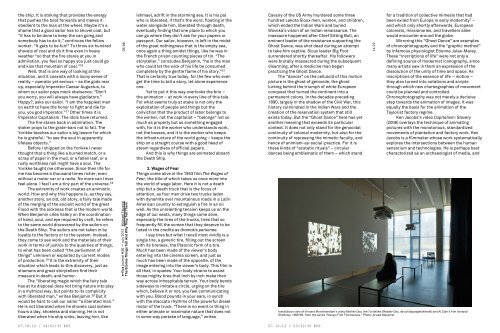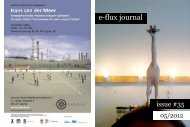You also want an ePaper? Increase the reach of your titles
YUMPU automatically turns print PDFs into web optimized ePapers that Google loves.
the ship. It is stoking that provides the energy<br />
that pushes the boat forwards and makes it<br />
obedient to the man at the wheel. Maybe it’s a<br />
shame that a good sailor has to shovel coal, but<br />
“it has to be done to keep the can going and<br />
somebody has to do it,” continues the fellow<br />
worker. “It gets to be fun!” To throw six hundred<br />
shovels of coal and do it fine even in heavy<br />
weather “so that the fire stares at you in<br />
admiration, you feel so happy you just could go<br />
and kiss that mountain of coal.” 16<br />
Well, that is one way of looking at the<br />
situation, and it coexists with a loony sense of<br />
reality – operatic yet serious – as the gods rear<br />
up, especially Imperator Caesar Augustus, to<br />
whom our sailor pays mock obeisance: “Don’t<br />
you worry, you will always have gladiators.”<br />
Happy?, asks our sailor. “I am the happiest man<br />
on earth to have the honor to fight and die for<br />
you, you god imperator.” 17 Other times it is<br />
Imperator Capitalism. The idols have returned.<br />
The fire stares back in admiration. The<br />
stoker prays to the grate-bars not to fall. The<br />
Yorikke teaches our sailor a big lesson for which<br />
he is grateful: “to see the soul in apparently<br />
lifeless objects.”<br />
Before I shipped on the Yorikke I never<br />
thought that a thing like a burned match, or a<br />
scrap of paper in the mud, or a fallen leaf, or a<br />
rusty worthless nail might have a soul. The<br />
Yorikke taught me otherwise. Since then life for<br />
me has become a thousand times richer, even<br />
without a motor car or a radio. No more can I ever<br />
feel alone. I feel I am a tiny part of the universe. 18<br />
The extremity of work creates an animistic<br />
world. How and why this happens is, as they say,<br />
another story, an old, old story, a fairy tale made<br />
of the merging of the ancient world of the great<br />
Flood with the sickness that is the modern world.<br />
When Benjamin cites Valéry on the coordination<br />
of hand, soul, and eye required by craft, he refers<br />
to the same world discovered by the sailors on<br />
the Death Ship. The sailors are not taken in by<br />
loyalty to the factory or to the system. Instead,<br />
they come to see work and the materials of their<br />
work in terms of justice to the qualities of things,<br />
to what has been called “the parliament of<br />
things” unknown or exploited by current modes<br />
of production. 19 It is the extremity of their<br />
situation which leads to this discovery, just as<br />
shamans and great storytellers find their<br />
measure in death, and humor.<br />
The “liberating magic which the fairy tale<br />
has at its disposal does not bring nature into play<br />
in a mythical way, but points to its complicity<br />
with liberated man,” writes Benjamin. 20 But it<br />
would be hard to call our sailor “a liberated man.”<br />
He is not liberated when he shovels coal sixteen<br />
hours a day, shoeless and starving. He is not<br />
liberated when his ship sinks, leaving him, like<br />
07.18.12 / 04:01:33 EDT<br />
05/08<br />
e-flux journal #36 — july 2012 Michael Taussig<br />
The Stories Things Tell And Why They Tell Them<br />
Ishmael, adrift in the storming sea. It is his pal<br />
who is liberated, if that’s the word, floating in the<br />
water alongside him, liberated through death,<br />
eventually finding that one place to which you<br />
can go where they don’t ask for your papers or<br />
passport. Our sailor, however, is left in the midst<br />
of the great nothingness that is the empty sea,<br />
once again a thing amidst things, like he was in<br />
the French prison counting pieces of tin. “The<br />
storyteller,” concludes Benjamin, “he is the man<br />
who could let the wick of his life be consumed<br />
completely by the gentle flame of his story.” 21<br />
That is certainly true today, for the few who even<br />
get the time to tell a story, let alone experience<br />
one.<br />
Yet to put it this way overlooks the brio –<br />
the animation – at work in every line of this tale.<br />
For what seems truly at stake is not only the<br />
exploitation of people and things but the<br />
conviction that the product of labor belongs to<br />
the worker, not the capitalist – “belongs” not so<br />
much as property but as something engaged<br />
with, for it is the worker who understands work,<br />
not the bosses, and it is the worker who keeps<br />
the infrastructure of the world going – keeps the<br />
ship on a straight course with a good head of<br />
steam regardless of official papers.<br />
And this is why things are animated aboard<br />
the Death Ship.<br />
3. Wages of Fear<br />
Things come alive in the 1953 film The Wages of<br />
Fear, the title of which takes us once more into<br />
the world of wage labor. Here it is not a death<br />
ship but a death truck that is the focus of<br />
attention, as four men drive two trucks laden<br />
with dynamite over mountainous roads in a Latin<br />
American country to extinguish a fire in an oil<br />
well. As the unrelenting tension keeps us on the<br />
edge of our seats, many things come alive,<br />
especially the tires of the trucks, tires that so<br />
frequently fill the screen that they deserve to be<br />
listed in the credits as dramatis personae.<br />
I say tires but what I recall most vividly is a<br />
single tire, a generic tire, filling out the screen<br />
with its tireness, the Platonic form of a tire.<br />
Much has been made of the viewer’s body<br />
entering into the cinema screen, and just as<br />
much has been made of the opposite, of the<br />
image entering into the viewer’s body. This film is<br />
all that, in spades. Your body strains to assist<br />
those mighty tires that inch by inch make their<br />
way across inhospitable terrain. Your body bends<br />
sideways to imitate a circle, urging on the tire<br />
which, believe it or not, you feel communicating<br />
with you. Blood pounds in your ears, in synch<br />
with the staccato rhythms of the powerful diesel<br />
motor of the truck. “There is no event or thing in<br />
either animate or inanimate nature that does not<br />
in some way partake of language,” writes<br />
Cavalry of the US Army murdered some three<br />
hundred Lakota Sioux men, women, and children,<br />
which ended the Indian Wars and buried<br />
Wovoka’s vision of an Indian renaissance. The<br />
massacre happened after Chief Sitting Bull, an<br />
eminent leader of the resistance supporting the<br />
Ghost Dance, was shot dead during an attempt<br />
to take him captive. Sioux leader Big Foot<br />
surrendered shortly thereafter. His followers<br />
were brutally massacred during the subsequent<br />
disarming, after a medicine man began<br />
practicing the Ghost Dance.<br />
The “dancer” on the celluloid of this motion<br />
picture is the ghost of genocide, the ghost<br />
lurking behind the triumph of white European<br />
conquest that turned the continent into a<br />
permanent colony. In the decades preceding<br />
1890, largely in the shadow of the Civil War, this<br />
history culminated in the Indian Wars and the<br />
creation of the reservation system that still<br />
exists today. But the “Ghost Dance” here has yet<br />
another meaning that exceeds its particular<br />
context. It does not only stand for the genocidal<br />
continuity of colonial modernity, but also for the<br />
continuity of repressing the mimetic faculty, and<br />
hence of animism-as-social-practice. For it is<br />
these kinds of “ecstatic rituals” – circular<br />
dances being emblematic of them – which stand<br />
14/22<br />
for a tradition of collective mimesis that had<br />
been exiled from Europe in early modernity 7 –<br />
and which only shortly afterwards, European<br />
colonists, missionaries, and travellers alike<br />
would encounter around the globe.<br />
Mirroring this “Ghost Dance” are examples<br />
of chronophotography and the “graphic method”<br />
by infamous physiologist Etienne Jules-Marey.<br />
These “inscriptions of life” were not only a<br />
defining source of modernist iconography, since<br />
many artists saw in them an expression of the<br />
dissolution of the unity of time and space. As<br />
inscriptions of the essence of life – motion –<br />
they also turned into notations and scripts<br />
through which new choreographies of movement<br />
could be planned and controlled.<br />
Chronophotography was not merely a decisive<br />
step towards the animation of images. It was<br />
equally the basis for the animation of the<br />
Taylorist factory regime.<br />
Ken Jacobs’s video Capitalism: Slavery<br />
(2006) overlays the technique of animating<br />
pictures with the monotonous, standardized<br />
movements of plantation and factory work. Ken<br />
Jacobs is a filmmaker whose work systematically<br />
explores the intersections between the human<br />
sensorium and technologies. He is perhaps best<br />
characterized as an archaeologist of media, and<br />
Installation view of Vincent Monnikendam's video Mother Dao, the Turtlelike (Moeder Dao, de schildpadgelijkende) and Al Clah's film Intrepid<br />
Shadows, 1966/69, from the series “Navajo Film Themselves.” Photo: Arwed Messmer.<br />
07.16.12 / 23:31:30 EDT









